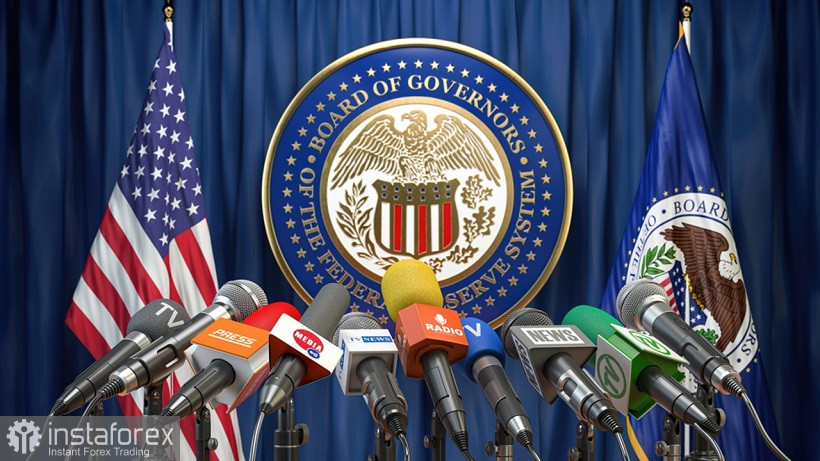The minutes of the Fed's July meeting published yesterday were actually ignored by the market, although the document itself was hawkish in nature. Most of the theses voiced turned out to be in favor of the US currency, but the market considered the document outdated due to the latest inflation releases, which reflected a slowdown in the main indicators.
In general, speaking of the Fed protocol, we can draw an allegory with the stars on the night vault—basically we see the light of those celestial bodies that are no longer there. The American regulator similarly assesses the situation at the moment "here and now," while the two-week time interval (from the moment of the meeting itself to the moment of publication of the document) partially negates the relevance of the protocol. Actually, for this reason, the EUR/USD pair reacted so poorly to the "minutes" of the Fed.
Nevertheless, some signals allowed the pair's bears to stay below 1.0200. In my opinion, one key point of yesterday's release should be highlighted.

Thus, members of the Fed made it clear that interest rates in the United States will remain high for a long time, so that inflation returns to the target range "on a sustainable basis." This is quite an important message, given the circulating rumors that the US regulator will start cutting rates in the second half of next year in order to further stimulate economic growth. Some representatives of the Fed were even forced to refute such assumptions. In particular, San Francisco Fed President Mary Daly said that the markets are "getting ahead too far" when discussing the timing of the interest rate cut.
Given this background, the signal that the Fed is preparing for a protracted fight against inflation can be unambiguously interpreted in favor of the greenback.
But again, it is necessary to understand that the July meeting was held even before the release of the latest inflationary data, which reflected a slowdown in key indicators. And in this context, another phrase that is present in the protocol is important: "The members of the Committee agreed that the future increase in the interest rate will depend on the incoming macroeconomic data. They also opined that "at some point" it would be appropriate to slow down the pace of the rate increase."
Against the background of the first signs of a slowdown in the CPI, this formulation will serve as a sword of Damocles for dollar bulls. For example, if the August data on the consumer price index growth also comes out in the "red zone," it will be safe to say that the Fed will decide only on a 50-point rate hike. And both in September and in November.
Thus, despite certain hawkish signals that were present in the text of the minutes of the July Fed meeting, traders quite rightly ignored the document itself. After all, the de facto published "minutes" did not clarify the situation regarding the further pace of monetary tightening, but reflected the situation that developed at the end of last month. Since then, more recent reports have been published on the growth of the consumer price index, producer price index, import price index. All of these releases came out in the "red zone."
Moreover, before the September meeting, the August Nonfarm Payrolls and CPI growth report will still be published. Therefore, of all the theses voiced in the protocol, perhaps the most relevant is the thesis that the Fed is ready to keep rates at a high level "for a long time." As for the pace of monetary policy tightening, the information published here is clearly outdated.
In other words, the "Fed minutes" did not allow the EUR/USD bears to develop a downward momentum. The pair is still in the grip of the price range of 1.0130–1.0280, but this week the volatility has decreased: traders have narrowed the flat corridor to 1.0140–1.0200, alternately starting from its borders.
A little support for the euro was provided today by ECB representative Martins Kazaks: he said that the European Central Bank "will continue to raise interest rates on a large scale in order to prevent inflation from taking root." However, this hawkish signal was leveled by his colleague, ECB Governing Council member Isabel Schnabel. According to her, there are a number of indicators indicating the risk of weakening inflation expectations. In addition, today, it became known that the July HICP index in the eurozone was revised downward (0.1% MoM), while the initial estimate was at 0.8%.
Summarizing the above, we can conclude that the fundamental picture for the EUR/USD pair has not changed significantly since yesterday. The published minutes of the Fed aroused some interest, but did not provoke increased volatility. The pair continues to trade within the above range amid relative calm. Therefore, when the price growth fades in the area of 1.0210 (the middle line of the Bollinger Bands indicator on the daily chart), short positions can be considered to the support level of 1.0120 (the lower line of the Bollinger Bands on the same timeframe).





















